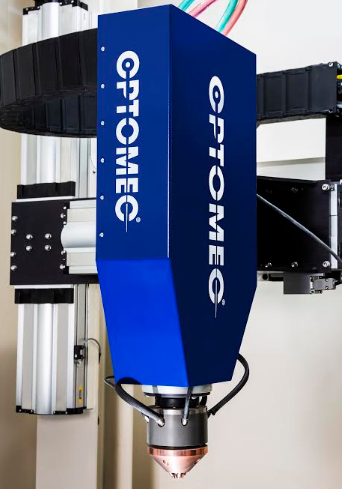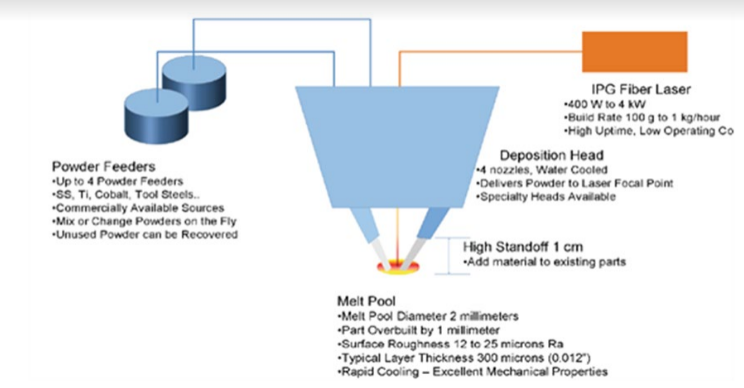Optomec has just announced the LENS Laser Deposition Head (LDH 3.X) for additive manufacturing users around the world in need of a powerful optics system. Headquartered in Albuquerque, New Mexico, Optomec leads in the supply of production-grade AM metal systems, outlining their latest research and development in ‘Effects of Power Density on Additive Manufacturing.’
This new 3D printing hardware represents a significant shift in the world of optics manufacturing, with a system able to create three discreet focused spot sizes as required by users, in line with changes in laser power. Supporting a variety of laser powers, the LDH 3.X maintains high performance DED processing for many different parts and applications.
“As metal additive manufacturing users continue to seek higher laser powers, faster speeds, and improved deposition rates to maximize production, they don’t want to sacrifice the quality of the build. Controlling power density during processing becomes a critical factor,” said Tom Cobbs, LENS product manager at Optomec. “The new LDH 3.X is a marked advancement in sophistication for DED processing. Its versatility, robustness, and ease-of-use empower the user to control laser power density at the workpiece for optimal results across a wide range of industrial applications.”
 Harnessing higher laser power for optimal DED processing, the LDH 3.X system offers:
Harnessing higher laser power for optimal DED processing, the LDH 3.X system offers:
- Advanced cooling
- High power duty cycles
- Variable optics
- Improved channeling for water cooling the printhead
The LDH 3.X will not overheat even while printing at high temperatures for long build times. The powerful system also offers added versatility with a connect/disconnect nozzle system. This means that users can switch out nozzles depending on the applications required. Users are enabled due to the number of options they can employ depending on their particular needs for a prototype or part; for instance, they can choose to use a 0.6mm focused spot size for smaller, more complex geometries.
 For other jobs, they may use a 2mm or 3mm focused spot size. Whether they are fabricating small or large builds or jobs requiring high power, repair of defects, finishes and coatings, or cladding, the LDH 3.X offers the flexibility necessary for industrial applications.
For other jobs, they may use a 2mm or 3mm focused spot size. Whether they are fabricating small or large builds or jobs requiring high power, repair of defects, finishes and coatings, or cladding, the LDH 3.X offers the flexibility necessary for industrial applications.
Available now, most LENS systems start at $10,000 (to upgrade from LDH 2.0). Optomec offers different optics and nozzles separately and included ‘material starter recipes’ for assistance in speed adoption.
3D printing has served as an enormous boon to the optics industry, allowing all the benefits of 3D printing to be taken advantage of by users worldwide—from greater affordability in manufacturing overall, faster production, reduction in manpower required, ease in customization, and more. Manufacturers and researchers are behind the innovation of systems allowing for embedding of geometric options, micro-optics at the nanoscale, and other specialized hardware.
What do you think of this news? Let us know your thoughts; join the discussion of this and other 3D printing topics at 3DPrintBoard.com.
[Source / Images: Optomec]Subscribe to Our Email Newsletter
Stay up-to-date on all the latest news from the 3D printing industry and receive information and offers from third party vendors.
You May Also Like
Further Understanding of 3D Printing Design at ADDITIV Design World
ADDITIV is back once again! This time, the virtual platform for additive manufacturing will be holding the first-ever edition of ADDITIV Design World on May 23rd from 9:00 AM –...
3D Printer Maker EVO-tech Reborn as NEVO3D — Once More With Feeling
EVO-tech was a 3D printing service and original equipment manufacturer established in 2013 and based in Schörfling am Attersee, Austria. The company produced high-quality material extrusion systems featuring linear bearings,...
3D Systems Brings 3D Printed PEEK Cranial Implant to the U.S. with FDA Clearance
For more than 10 years, 3D Systems (NYSE:DDD) has worked hand-in-hand with surgeons to plan over 150,000 patient-specific cases, and develop more than two million instruments and implants from its...
CDFAM Returns to Berlin for Second Annual Symposium
The second CDFAM Computational Design Symposium is scheduled for May 7-8, 2024, in Berlin, and will convene leading experts in computational design across all scales. Building upon the first event...
































